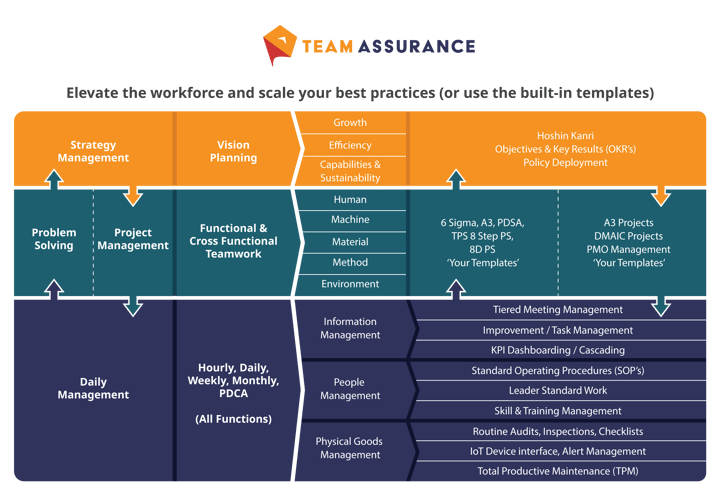Setting Expectations: What does a good day look like?

We discuss why clearly setting expectations and objectives is critical to engaging teams, boosting employee morale, and enabling continuous improvement.
What does a good day look like for you and your team?
It’s a simple question but one many people in our organisations would struggle to answer clearly. The specifics of what it was they were trying to achieve each day are often hard to articulate. This is particularly relevant for the people working on the frontline. There are often significant gaps in leadership’s ability to provide clear, timely, inclusive communication. There are also gaps when it comes to drip feed knowledge on an ad hoc basis.
It’s interesting that we expect people to give their time, their effort and best endeavours to a cause yet the cause is often ill defined. We regularly leave people in the dark regarding the real purpose and objectives.
The power of setting expectations and objectives
I often refer to, and reflect on, an example I read about of two groups of cleaners from separate hospitals. These groups were interviewed and asked about how they viewed their role. One group talked about the fact that their work was of low standing, it was lowly paid, and centred on menial dirty work. They did the basics of what they needed to do and that was it.
There was no higher purpose or objective to the work they did and they didn’t see their contribution beyond that. The morale and the enthusiasm in the team was low; the team received little to no feedback on their performance.
On the other hand, the second group recognised that their work contributed to a clean, sterile and pleasant environment. They noted that they provided a service that was a contributing factor to helping people’s healthcare and treatment journey, as well as recovery from illness and injury. The team viewed their work as highly valued and important. As such the group took great pride and ownership over the quality of the work. This team was highly motivated and had a positive and engaged mindset. They looked for ways to continuously improve what they did and how they did it.
These people were all paid the same – so what was the difference?
Setting expectations can be a real motivator
The difference is that one group had a clear sense of what was expected from them. This group understood how and why their job contributed to the hospital’s overall goal. The other team did not.
When it was clearly communicated and woven into the daily focus and standards of their work, the second team clearly understood why providing the best environment to deliver healthcare services contributed to positive patient outcomes. This enabled them to continue to build on that foundation of understanding.
Of course, this is looking at things from a high level but you get the point.
When we can create environments that facilitate the smooth and effective flow of information and communication around a set of clearly defined shared goals then we are in a position to truly engage people. Engaging people is the ability to capture their hearts, minds, and imaginations. It allows us to have them own their part of the mission no matter how big or small.
We must understand that everyone has a part to play and that the team cannot succeed long term without these parts working together in harmony toward a set of common aspirations, goals, and standards.
Understanding the ‘why’ behind organisational expectations
Shaping the ‘Why’ through our daily habits and routines is the key to success. When people can come together to visualise specifically what it is they are setting out to achieve each day then we have a platform for success.
Whether it is one thing or a suite of qualitative and quantitative metrics – a clear description of the expectations of performance and behaviour in the environment provides a meaningful point of reference. It’s amazing what starts to happen to strategy deployment efforts in environments where there has been a lack of metrics and accountability when clarity of purpose is introduced. Put simply: things start to improve, like magic.
People improve simply because we can now define what is important to us. Human beings like to have a sense of achievement; they take pride and develop status through achieving results. Having clear objectives stretches us and forces us to expose the things that impede our ability to succeed. They force us to think differently and innovate. Clear expectations enable critical thinking toward problem-solving and iterative improvement.
A clear sense of shared goals, as well as our individual and discreet part of that process enables us to come together as a community. We work together for the common good. This provides a sense of identity and belonging. We know what it is we need to do and why we need to do it. We also know what the person next to us on our team is doing and why.
Expectation setting relies on a culture of effective leadership
This dynamic relies on leadership to support the team and the process. It also requires leadership to be the conduit through which information flows and resources are allocated. It is the job of the leader to facilitate the effective communication of our objectives. Leaders are also relied upon to ensure that people not only understand the purpose but have the means and the capability to do what is required.
Communicating objectives is best achieved visually and when we can build structures such as tier meetings with daily visual management to enable this we are well placed to have more and more – good days.
Alignment on objectives involves the entire C.I. framework
To achieve alignment of all our people when it comes to objectives and expectations, we must consider how all our varying processes and systems connect. The alignment of our Lean tools like standardised problem solving techniques, Standard Operating Procedures (SOPs), and a Tiered Daily Management process that supports the entire PDCA loop are key to achieving success in this regard.
The illustration below demonstrates how we designed an interconnected TeamAssurance platform to avoid locally optimised, disconnected ‘Point Solutions’ (digital or analog) that obscure our understanding of objectives and expectations.

If you’re a business in need (or a consultant with clients in need) and you'd like to explore the opportunities that digital-aids to Lean tools provide contact us for a demonstration of the TeamAssurance platform today.


